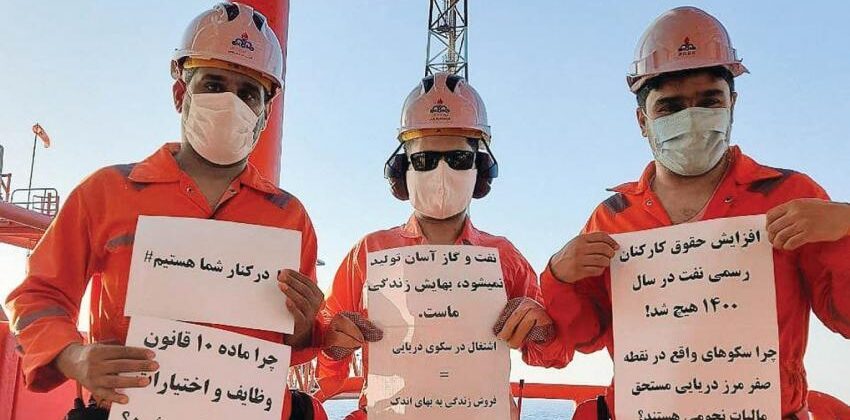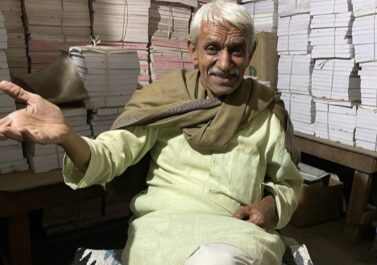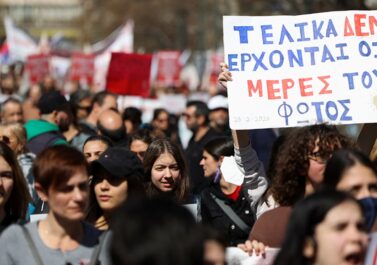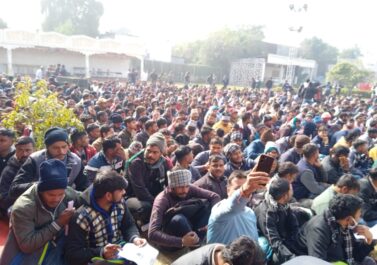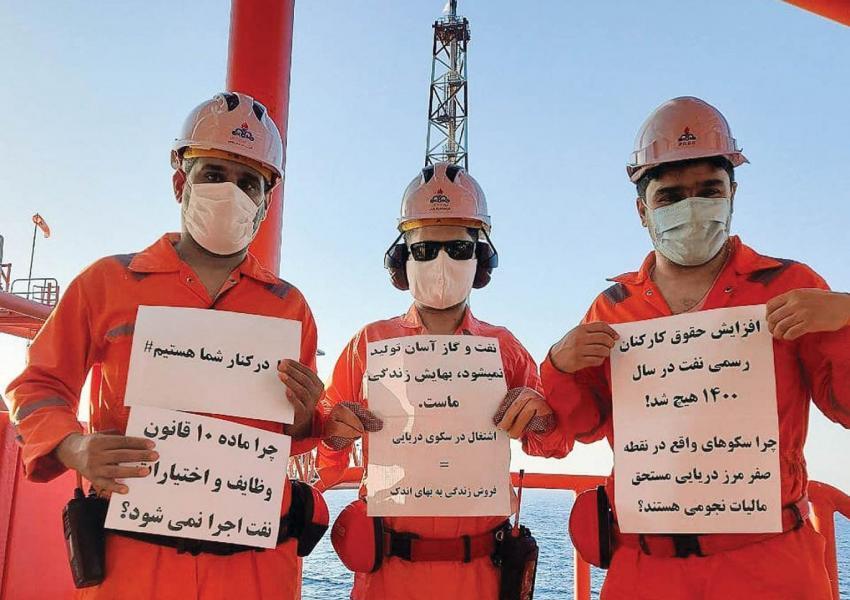
by Iman Ganji and Jose Rosales
Comrades sent us following observations on the recent oil workers strike in Iran. For further reading on recent struggles in the region we recommend this article on the wider learning processes of the working class. We think the descriptions of the divisions within the oil workers is relevant, but we would like to question the conclusion of the comrades. While workers’ struggles will have to overcome sectorial boundaries we don’t think that ‘the surplus population’ or ‘the human strike’ are concepts that can help us to understand how the working class can re-compose itself and overcome the uneven development that is imposed on its movements. To be continued!
Iranian workers employed by contractor companies in the oil industry have been for 13 days in a general strike. The strike has reached more than 70 centers in the industry and more than 60,000 workers have taken part.
What is significant in this “general strike” among the oil industry workers is the direction it has developed: from the lowest ranking, most precarious workers who have temporary, even zero hours contracts (i.e. “project workers”) to workers who are officially employed. The hierarchy that is imposed on these workers, which organizes their fragmentation and thereby renders any “class alliance” impossible, is a horrifying and complex process. And it is worth mentioning that the NIOC workers’ general strike was decisive in the downfall of Pahlavi Monarchy in 1979
The strikers work for companies contracted by the National Iranian Oil Company (NIOC) in the process of economic (neo)liberalization that began in the early ‘90s. What resulted from this period was the trend of outsourcing work to different forms of private contractor companies and the consequent precarization of labor.
There is a labyrinth of contractor companies active in the Iranian oil industry. There are main contractors with the NIOC. They also contract different jobs and services of their projects to other, smaller contractors. There are also human resource contractor companies that make contracts with workers and distribute them to other larger or smaller contractors.
Inside contractor companies, there are different forms of contract: employed workers with fixed terms contracts, temporary workers with less than a year contracts, temporary workers with monthly or daily or zero hours contracts. There are even “oral” contracts between some of these workers and their contractor employers. The wages naturally differ between these groups.
There was already an income gap between white collar employees of the NIOC and the official workers. The conditions for such exploitation started with a hideous manipulative process of turning blue collar workers into while collar workers. The blue collar workers could still complain for wages and insurance under the national labor law and go into strike for meeting demands. But the white collar employees were under the NIOC terms of employment and they did not have the right to refer to the national labor law and its regulations and its limited possibilities for workers’ right to assemble and protest. Looking at the benefit gap between themselves and the white collar employees, many workers accepted to be contracted as a white collar. But of course, according to NIOC regulations about expertise and form of labor, they stayed with lower income and less benefits. Unable to complain according to the labor law, many were faced with two options: starvation wages or early retirement with a lump sum. Many selected the second option.
After many workers were basically thrown out, the NIOC started outsourcing and the precarization of its labor force began intensely. On the precarization of labor in NIOC until 2013, see Mohammad Maljoo’s research here.
There are of course two other lines of fragmentation here: ethnicity/race and gender.
The oil industry center is in the south region with mainly Arab and Lor populations and other minorities. The local people are those who are employed with lowest wages and have the most precarious contracts. Women are much less present in the oil industry in Iran, with some as official white collar employees. But the rest of them are working in services such as kitchen and other forms of care labor and they also have very precarious conditions.
It is evident that such a hyper-categorization and fragmentation creates different “interests” inside the oil industry workers as a whole. There is also the main duality between “unofficial workers” (those who are working with contractor companies) and “official workers” (who are employed by the NIOC and are in strategic positions in the production). There are signs that show the limits and also the effectiveness of such fragmentations.
Many statements by different unions and precarious workers, women movement and feminists, pensioners, truck drivers, teachers, nurses, etc are supporting the strikers and show solidarity. This was a reminder of this year’s May Day, when various organizations called for protests or supported protests to improve living conditions. The workers were once the main symbol of the lower class, but the coalition that has emerged in recent protests through the declaration of solidarity, including in the case of May Day, is more diverse and pervasive than what is traditionally called the “workers.” Government retirees, teachers, nurses, contract workers, drivers, women, the unemployed, apprentices, ranchers, farmers, industrial workers and other small-scale producers are all now part of this protesting coalition, all with calls to end neoliberalization and precarization of labor.
The call to strike by the contractors’ workers, the “precariat” of Iranian oil industry (the main source of GDP in Iran), included the demands by the “official” workers. If the demand of the project workers were not met, the “official” workers were supposed to join the strike on Wednesday 30 June. They did not stop the work, but some of them organized protest marches and showed solidarity with the project workers.
The truck drivers, another part of the precarious labor force of the industry distributing goods such as oil, have also shown solidarity with oil project workers. Some of them have joined the strike by striking themselves. They have their own demands. Some bus drivers also staged a protest in support of oil workers and also voiced their own demands.
The government is already working on the fragmenting lines to slow down the protests and break the worker’s strike. By outsourcing to contractor companies, NIOC has multiplied the employers facing the workers and the ministry takes no responsibility for “unofficial” workers. But at the same time, the parliament passed regulations to increase the benefits of the “official” workers. The contractor companies have already fired hundreds of workers in different centers.
The workers in Asaluyeh, the site for the land based facilities of the huge PSEEZ (Pars Special Energy Economic Zone) project, are living in crowded camps with little hygiene. Right now, the temperature during the day averages around 41-42 Celsius. The employers, in coordination with the security apparatus, have stopped or limited delivering water and food and cut strikers’ access to phone and internet. They want them to leave the camp and thus ensure that this strike comes to an end. Instead, faced with the expensive price of water there, workers all chipped in and bought water tankers for themselves.
The Marxist traditions still dominant have long been criticized for equating the factory with the site of communist organizing; based on the assumption that the factory is structurally the most potent with revolutionary possibilities given that it convenes workers, en masse, in one space and around machinery that inevitably necessitates communication and cooperation. It was that this cooperation had an excess that cannot be absorbed in the reproduction cycle that led such traditions to posit the factory as capable of creating conditions for revolutionary organization of the workers.
The precarious workers with different forms of temporary contracts with the contractor companies are often working at the same space with those who have fixed contracts with contractor companies and/or are official employees of the Iranian Oil Company. But this has not fully surpassed the new process of making salami out of social flesh.
However, looking at what is happening right now, there is an excess of cooperation, of a kind of labor of love (the language of equality and solidarity), that cannot be absorbed even through hyper-fragmentation of the labor force.
A strike that begins not from waged-labour but from the surplus population capital presupposes is the material precondition to transform struggles over wages, labour conditions, pensions, etc., into a generalized struggle against both the forms of direct-domination that defines the production process and the extra-economic forms of indirect-domination that reproduce our dependence on markets and states for mere subsistence and at an ever increasing rate. This type of strike would be precisely what Claire Fontaine understood by the notion of a HUMAN Strike, which strikes not simply against the circuits of production but seeks ‘to wildcat the totality’, whose structural logic remains bound to the value form-determinations of capital.
